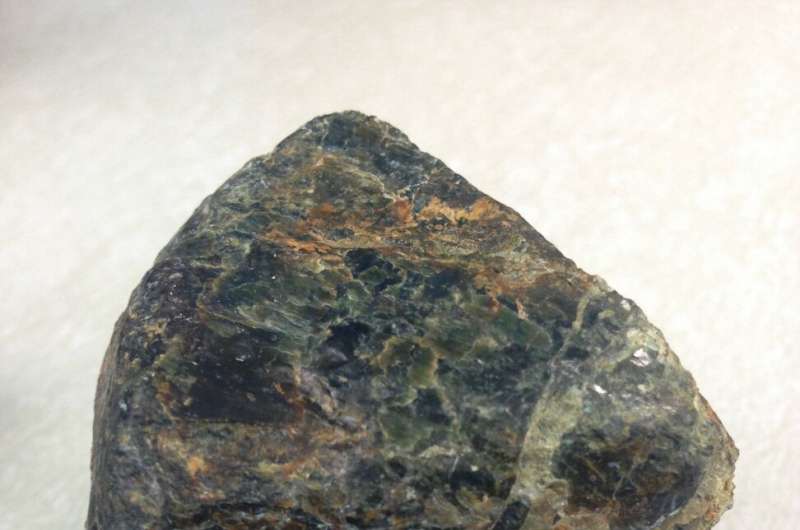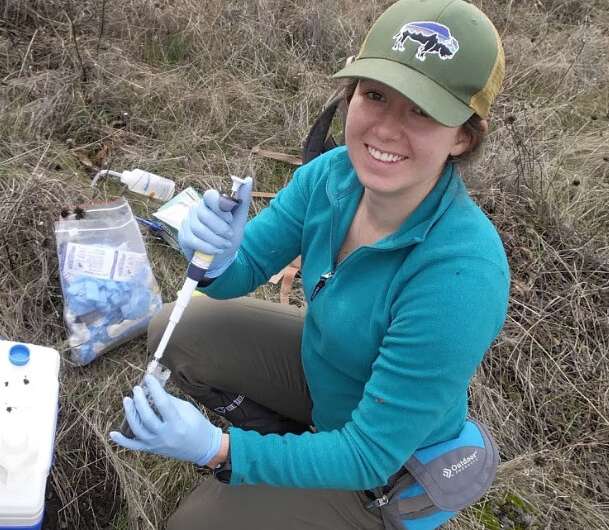Extreme environments provide clues to extraterrestrial life

Over the past decade, the NASA Astrobiology Institute funded Michigan State University geomicrobiologist Matt Schrenk's lab to study life in the extreme environment of groundwater in a highly alkaline aquifer near Lower Lake, California. Because similar environments occur in space—in the subsurface of Mars and in the oceans of Saturn's icy moon Enceladus—the microorganisms found in this aquifer, and their behavior, may provide insight into potential extraterrestrial life.
Two former MSU Department of Earth and Environmental Sciences graduate students, Lindsay Putman and Mary Sabuda, have recently published papers on this research. They collaborated at the same field site, which is characterized by serpentinization, a process where iron-rich rock reacts with water to form serpentine minerals and releases reduced gases like hydrogen and methane.
Putman's research, published in mSystems, presents a community assembly model—an ecological approach that studies the makeup and number of microbial species in a location to explain the processes that drive changes in their composition over space and time. From 2011–2017, Putman and her colleagues took samples from the bottom of the six wells a few times a year.
"I wanted to know what forces and ecological processes shaped the distinct microbial communities we see in this location," said Putman, who is now a postdoctoral scholar at Michigan Technological University. "And more specifically, I was asking if these communities are primarily shaped by their extreme environment or if other factors are at play."

Surprisingly, the extremely high pH at the bottom of the well was not the only factor influencing community composition; the physical environment also played a big part. Because water in the aquifer moves at an extremely slow pace, taking about 300 years to travel a kilometer, microbial communities can't mix or interact with each other much. This isolation introduced a high level of random variation in microbial community composition. At the same time, extreme pH conditions resulted in microbial communities that are more genetically similar than expected by chance. Since Putman's research uses a large data set and spans many years, the paper offers reliable findings from the only large time scale study on this type of serpentinizing aquifer system.
At the same time, Sabuda published a paper on the first deep look into the water chemistry and microbial communities in the same aquifer system in JGR Biogeosciences. Instead of sampling only the very bottom of each well at the site, as Putman and others have done, Sabuda sampled water at five different depths in just one well. She looked closely at the small-scale processes going on under the surface.
"The well is like a window into what's happening underground," said Sabuda, who is currently a Science Policy Fellow at the American Chemical Society in Washington, D.C. "As you get deeper, less oxygen is available, and the conditions become more extreme."
Sabuda found that in this environment, the microbes consume compounds like hydrogen and carbon monoxide, leaving the potent greenhouse gas methane to diffuse into the soils and perhaps into the atmosphere. Further investigation is necessary to determine environmental effects from these processes at the surface.

"I am extremely proud of the work that both Lindsay and Mary published," said Schrenk, EES associate professor. "They both started with a geoscience background, shaped their interdisciplinary ideas through teamwork in the field, and produced cutting-edge research that will have profound influences on the field of geomicrobiology.
"They were also the intellectual drivers for all areas of the science in these papers, from genomics, to hydrology, to thermodynamic modeling," he added. "The breadth of the work and its integration are a testament to their skill and creativity."
The findings in both papers help create a more complete picture of this extreme environment beneath our feet and provide clues for what life may be like beyond our planet. Their studies open the door for more research at this and similar extreme sites targeted for geological carbon dioxide sequestration to combat climate change.
"Ultimately, we found out in very different ways that things are far more complicated than they seem," Sabuda said. "We collect samples, do calculations, and build models that help us to understand how these microbes live, but there is still a lot of work remaining to fully understand these systems. We are excited to see what future research discovers."
More information: Lindsay I. Putman et al, Microbial Communities in a Serpentinizing Aquifer Are Assembled through Strong Concurrent Dispersal Limitation and Selection, mSystems (2021). DOI: 10.1128/mSystems.00300-21
Mary C. Sabuda et al, Biogeochemical Gradients in a Serpentinization‐Influenced Aquifer: Implications for Gas Exchange Between the Subsurface and Atmosphere, Journal of Geophysical Research: Biogeosciences (2021). DOI: 10.1029/2020JG006209
Provided by Michigan State University




















